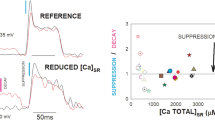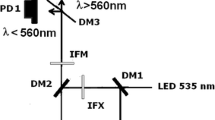Abstract
Raising the intracellular [Ca2+] ([Ca2+]i) was previously found to produce uncoupling between the electrical depolarization of the transverse tubules and contraction in skinned muscle fibers. Here we study the effect of elevated [Ca2+]i in voltage clamped cut fibers of frog skeletal muscle to establish how the charge movement, a measure of the activation of the dihydropyridine receptors (DHPR)-voltage sensors, and Ca2+ release, a consequence of the opening of the ryanodine receptor (RyR)-release channels, were affected. [Ca2+]i was raised by various procedures (pharmacological release from the sarcoplasmic reticulum, application of high [Ca2+]i intracellular solution, permeabilization of the plasma membrane by a Ca2+ ionophore) all of which produced impairment of excitation–contraction coupling. The charge movement was reduced from 20.2 ± 1.24 to 9.9 ± 0.94 nC/μF meanwhile the Ca2+ release flux was reduced from 13.5 + 0.7 to 2.2 ± 0.3 μM/ms (n = 33). This suggests that a significant fraction of the DHPRs that remained functional, could not activate RyRs, and were therefore presumably disconnected. These results are broadly consistent with the original reports in skinned fibers. Uncoupling was prevented by the addition to the intracellular solution of the protease inhibitor leupeptin. In approximately 40 % of the uncoupled cells we observed that the [Ca2+]i transient continued to rise after the voltage clamp pulse was turned off. This loss of control by membrane voltage suggests that the uncoupled release channels might have another mechanism of activation, likely by Ca2+.







Similar content being viewed by others
References
Brum G, Ríos E, Stefani E (1988) Effects of extracellular calcium on calcium movements of excitation-contraction coupling in frog skeletal muscle fibres. J Physiol 398:441–473
Bruton JD, Lännergren J, Westerblad H (1995) Mechano-sensitive linkage in excitation-contraction coupling in frog skeletal muscle. J Physiol 484:737–742
Bruton JD, Lännergren J, Westerblad H (1996) Effects of repetitive tetanic stimulation at long intervals on excitation-contraction coupling in frog skeletal muscle. J Physiol 495:15–22
Bruton JD, Szentesi P, Lännergren J, Westerblad H, Kovacs L, Csernoch L (2000) Frog skeletal muscle fibers recovering from fatigue have reduced charge movement. J Muscle Res Cell Motil 21:621–628
Chin ER, Allen DG (1996) The role of elevations in intracellular Ca2+ concentration in the development of low frequency fatigue in mouse single muscle fibres. J Physiol 491:813–824
Chin ER, Balnave CD, Allen DG (1997) Role of intracellular calcium and metabolites in low-frequency fatigue in mouse skeletal muscle. Am J Physiol Cell Physiol 272:C550–C559
Csernoch L (2007) Sparks and embers of skeletal muscle: the exciting events of contractile activation. Pflugers Arch 454:869–878
De Armas R, González S, Brum G, Pizarro G (1998) Effects of 2,3-butanedione monoxime on excitation-contraction coupling in frog twitch fibres. J Muscle Res Cell Motil 19(8):961–977
Felder E, Franzini-Armstrong C (2002) Type 3 ryanodine receptors of skeletal muscle are segregated in a parajunctional position. PNAS 99:1695–1700
Fill M, Copello J (2002) Ryanodine receptors calcium channels. Physiol Rev 82:893–922
González A, Ríos E (1993) Perchlorate enhances transmission in skeletal muscle excitation contraction coupling. J Gen Physiol 102(373):421
Gonzalez A, Kirsch WG, Shirokova N, Pizarro G, Stern MD, Rios E (2000) The spark and its ember: separately gated local components of Ca2 + release in skeletal muscle. J Gen Physiol 115:139–158
Hill D, Simon BJ (1991) Use of ‘caged calcium’ in skeletal muscle to study calcium-dependent inactivation of SR calcium release. Biophys J 59:239a
Kovacs L, Rios E, Schneider MF (1983) Measurement and modification of free calcium transients in frog skeletal muscle fibres by a metallochromic indicator dye. J Physiol (Lond) 343:161–196
Lamb GD, Junankar PR, Stephenson DG (1995) Raised intracellular [Ca2+] abolishes excitation-contraction coupling in skeletal muscle fibres of rat and toad. J Physiol 489:349–362
Melzer W, Rios E, Schneider MF (1987) A general procedure for determining the rate of calcium release from the sarcoplasmic reticulum in skeletal muscle fibers. Biophys J 51:849–863
Murphy RM, Verburg E, Lamb GD (2006) Ca2 + activation of diffusible and bound pools of μ-calpain in rat skeletal muscle. J Physiol 576:595–612
Murphy RM, Dutka TL, Horvath D, Bell JR, Delbridge LM, Lamb GD (2013) Ca2 + -dependent proteolysis of junctophilin-1 and junctophilin-2 in skeletal and cardiac muscle. J Physiol 591(3):719–729
Ogawa Y (1994) Role of ryanodine receptors. Crit Rev Biochem Mol Biol 29:229–274
Olivera JF, Pizarro G (2010) A reappraisal of the Ca2+ dependence of fast inactivation of Ca2+ release in frog skeletal muscle. J Muscle Res Cell Motil 31:81–92
Pizarro G, Ríos E (2004) How source content determines intracellular ca2 release kinetics. simultaneous measurement of [ca2] transients and [h] displacement in skeletal muscle. J Gen Physiol 124(3):239–258
Pizarro G, Shirokova N, Tsugorka A, Ríos E (1997) ‘Quantal’ calcium release operated by membrane voltage in frog skeletal muscle. J Physiol 501:289–303
Rios E, Pizarro G (1991) Voltage sensor of excitation-contraction coupling in skeletal muscle. Physiol Rev 71:849–908
Shirokova N, Garcia J, Pizarro G, Rios E (1996) Ca2+ release from the sarcoplasmic reticulum compared in amphibian and mammalian skeletal muscle. J Gen Physiol 107:1–18
Simon BJ, Klein MG, Schneider MF (1989) Caffeine slows turn-off of calcium release in voltage clamped skeletal muscle fibers. Biophys J 55(4):793–797
Verburg E, Murphy RM, Stephenson DG, Lamb GD (2005) Disruption of excitation-contraction coupling and titin by endogenous Ca2+-activated proteases in toad muscle fibres. J Physiol 564:775–790
Verburg E, Dutka TL, Lamb GD (2006) Long-lasting muscle fatigue: partial disruption of excitation-contraction coupling by elevated cytosolic Ca2+ concentration during contractions. Am J Physiol Cell Physiol 290:C1199–C1208
Verburg E, Murphy RM, Richard I, Lamb GD (2009) Involvement of calpains in Ca2+-induced disruption of excitation–contraction coupling in mammalian skeletal muscle fibers. Am J Physiol Cell Physiol 296:C1115–C1122
Zhou J, Launikonis BS, Ríos E, Brum G (2004) Regulation of Ca2+ sparks by Ca2+ and Mg2+ in mammalian and amphibian muscle. An RyR isoform-specific role in excitation-contraction coupling? J Gen Physiol 124:409–428
Funding
This work was funded by CSIC (U. de la R.) Grant 659ID2012 to G.P. and PEDECIBA.
Author information
Authors and Affiliations
Corresponding author
Rights and permissions
About this article
Cite this article
Olivera, J.F., Pizarro, G. Excitation contraction uncoupling by high intracellular [Ca2+] in frog skeletal muscle: a voltage clamp study. J Muscle Res Cell Motil 37, 117–130 (2016). https://doi.org/10.1007/s10974-016-9446-4
Received:
Accepted:
Published:
Issue Date:
DOI: https://doi.org/10.1007/s10974-016-9446-4




